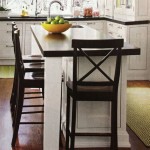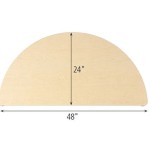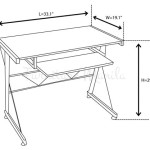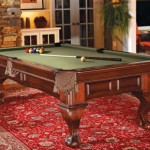Glass Table With Tree Trunk Base: An Exploration of Nature and Design
The fusion of natural elements with modern design principles has led to the emergence of unique furniture pieces, chief among them being the glass table with a tree trunk base. These tables represent a striking contrast between the organic and the manufactured, bringing the raw aesthetic of nature into contemporary living spaces. The marriage of a transparent glass tabletop and a robust, often untouched, tree trunk creates a focal point that is both functional and visually compelling.
This article delves into the various aspects of glass tables with tree trunk bases, exploring their aesthetic appeal, the sourcing and treatment of the wooden components, the different styles and applications, and the considerations involved in selecting and maintaining such a distinctive piece of furniture. This exploration aims to provide a comprehensive understanding of these tables, enabling informed decisions for potential buyers and enthusiasts alike.
Understanding the Aesthetic Appeal and Variations
The primary allure of a glass table with a tree trunk base lies in its inherent connection to the natural world. Unlike mass-produced furniture, each table is unique due to the individuality of the tree trunk used. The shape, texture, and grain patterns inherent in the wood contribute to the distinctive character of the table. The glass tabletop, by virtue of its transparency, allows for an unobstructed view of the tree trunk, effectively showcasing its natural beauty. This transparency also prevents the base from visually overwhelming the surrounding space, maintaining a sense of openness and airiness.
Variations in style are abundant. Some designs feature the tree trunk in its most raw and unadulterated form, with bark intact and natural imperfections celebrated. These pieces often evoke a rustic or woodland aesthetic, suitable for homes with a penchant for natural materials and earthy tones. Others involve more refined treatments of the wood, such as sanding, polishing, or staining, to achieve a more contemporary or sophisticated look. These options can seamlessly integrate into modern interiors, adding a touch of organic warmth to otherwise sleek and minimalist spaces.
The shape and style of the glass tabletop also contribute to the overall aesthetic. Round tabletops soften the angularity of the tree trunk, creating a more balanced and harmonious composition. Rectangular or square tops, on the other hand, offer a more structured and formal appearance. The thickness and edge treatment of the glass can further influence the table's style, ranging from thin, barely-there tops for a minimalist look to thick, beveled-edge tops for a more substantial and luxurious feel. The choice of glass itself, whether clear, tinted, or textured, presents another avenue for customization and personalization.
Beyond the aesthetic considerations, the size and scale of the table must be carefully considered in relation to the intended space. A large, imposing tree trunk base might be overwhelming in a small room, while a delicate base could be lost in a larger setting. Similarly, the height of the table should be appropriate for its intended use, whether as a coffee table, dining table, or side table. The proportions of the tree trunk to the glass top should also be visually balanced, ensuring that neither component dominates the other.
Ultimately, the aesthetic appeal of a glass table with a tree trunk base stems from its ability to bridge the gap between the natural and the artificial, offering a unique and captivating blend of organic beauty and contemporary design. The versatility of these tables allows them to complement a wide range of interior styles, adding a touch of character and individuality to any space.
Sourcing, Treatment, and Sustainability Considerations
The ethical and sustainable sourcing of the tree trunks used in these tables is of paramount importance. Responsible manufacturers prioritize the use of reclaimed wood or sustainably harvested timber. Reclaimed wood, often sourced from fallen trees, salvaged building materials, or driftwood, offers an environmentally friendly alternative to the felling of live trees. Sustainably harvested timber, on the other hand, comes from forests that are managed in a way that ensures their long-term health and productivity. Certifications like the Forest Stewardship Council (FSC) provide assurance that the wood has been sourced responsibly.
The treatment of the tree trunk is crucial for both its aesthetic appeal and its longevity. The initial steps typically involve cleaning and drying the wood to prevent rot and insect infestation. The drying process is particularly important, as it reduces the moisture content of the wood, minimizing the risk of warping or cracking over time. Kiln drying is a common method used to accelerate the drying process and ensure even moisture distribution throughout the wood.
Once the wood is dry, it may undergo further treatment to enhance its appearance and protect it from the elements. Sanding is often used to smooth the surface and remove any rough edges or imperfections. Staining can be applied to alter the color of the wood and highlight its natural grain patterns. Sealants and varnishes provide a protective layer that shields the wood from moisture, scratches, and UV damage. The choice of treatment depends on the desired aesthetic and the intended use of the table. For example, a table intended for outdoor use may require a more durable sealant than a table intended for indoor use.
The design and construction of the base also play a crucial role in its stability and durability. The tree trunk should be carefully selected for its structural integrity, ensuring that it can adequately support the weight of the glass tabletop. The base is often flattened or stabilized with additional supports to prevent wobbling or tipping. Metal brackets or plates may be used to reinforce the joints between the tree trunk and the tabletop, adding extra strength and stability.
Furthermore, ethical considerations extend to the labor practices involved in the manufacturing process. Responsible manufacturers prioritize fair wages, safe working conditions, and the use of environmentally friendly materials and processes. By supporting such manufacturers, consumers can contribute to a more sustainable and ethical furniture industry.
Applications, Maintenance, and Considerations for Selection
Glass tables with tree trunk bases are remarkably versatile and can be incorporated into various settings and for diverse purposes. In living rooms, they serve as striking coffee tables, providing a focal point for the space and a surface for drinks, books, and decorative items. In dining rooms, they can be used as dining tables, creating a rustic yet elegant atmosphere for meals. As side tables or end tables, they add a touch of natural charm to bedrooms, hallways, or home offices.
Beyond their functional roles, these tables can also serve as artistic statements. Incorporating them into a gallery space or a reception area can elevate the ambiance, adding a touch of organic sophistication. The unique character of each table ensures that it becomes a conversation starter, drawing attention and sparking interest.
Maintaining a glass table with a tree trunk base requires careful attention to both the glass and the wood components. The glass tabletop can be cleaned with standard glass cleaners and a soft cloth to remove fingerprints, smudges, and dust. Avoid using abrasive cleaners or scouring pads, as these can scratch the glass. Regular dusting of the tree trunk base will prevent the buildup of dirt and debris. Depending on the finish, the wood may also require occasional polishing or waxing to maintain its luster and protect it from moisture.
When selecting a glass table with a tree trunk base, several factors should be considered. The size and shape of the table should be appropriate for the intended space and use. The style of the table should complement the existing décor and personal preferences. The quality of the materials and construction should be carefully assessed to ensure durability and longevity. It is also essential to consider the ethical and sustainable sourcing of the wood and the labor practices involved in the manufacturing process.
Finally, consider the weight of the table, especially if it needs to be moved frequently. A solid tree trunk base can be quite heavy, requiring assistance for lifting and transportation. Ensure that the floor surface is capable of supporting the weight of the table without causing damage. By carefully considering these factors, potential buyers can make informed decisions and select a glass table with a tree trunk base that will provide years of enjoyment and add a touch of natural beauty to their homes.

Teak Root Dining Table Homeplus Furniture

Tree Stump Table Base Options D I Y Rustic Wood Coffee Tables

Large Teak Root Dining Table Homeplus Furniture

Tree Stump Glass Coffee Table With Metal Base

Grapevine Dining Table Calabrese Made From Retired In Kitchen

Pin On Garden

Organic Modern Substantial Glass Top Dining Table With Cypress Tree Tr

Rustic Furniture Glass Top Tables

Saguaro Trunk Table Base

Custom Glass Top Coffee Table On 19th C European Natural Wood Tree Stump Base
Related Posts








